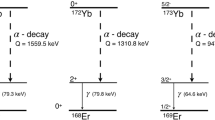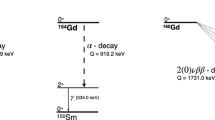Abstract
The first ever search for \(\alpha \) decays to the first excited state in Yb was performed for six isotopes of hafnium (174, 176, 177, 178, 179, 180) using a high purity Hf sample of natural isotopic abundance with a mass of 179.8 g. For \(^{179}\)Hf, also \(\alpha \) decay to the ground state of \(^{175}\)Yb was searched for thanks to the \(\beta \)-instability of the daughter nuclide \(^{175}\)Yb. The measurements were conducted using an ultra-low-background HPGe-detector system located 225 m underground. After 75 days of data taking no decays were detected but lower bounds for the half-lives of the decays were derived on the level of \(\lim T_{1/2}\sim 10^{15}{-}10^{18}\) a. The decay with the shortest half-life based on theoretical calculation is the decay of \(^{174}\)Hf to the first \(2^+\) 84.3 keV excited level of \(^{170}\)Yb. The experimental lower bound was found to be \(T_{1/2}\ge 3.3\times 10^{15}\) a.







Similar content being viewed by others
Data Availability Statement
This manuscript has no associated data or the data will not be deposited. [Authors’ comment: The data can be supplied by the authors on demand.]
Notes
In the spectrum of the detector Ge10 there is a structure near the energy of interest with an area \(20.2 \pm 10.2\) counts, which is no evidence of the effect searched for (see text below and Fig. 5).
One can see in Table 5 that the strongest half-life limit was obtained with the detector Ge7 in set-up I. However, the large \(\lim T_{1/2}\) appears due to a negative peak area, which results in a small \(\lim S\) value. We prefer to use the estimation obtained from the higher statistics acquired with the detector Ge7 in set-ups I and II.
References
P. Belli et al., Experimental searches for rare alpha and beta decays. Eur. Phys. J. A 55, 140 (2019)
J. Meija et al., Isotopic compositions of the elements 2013 (IUPAC Technical Report). Pure Appl. Chem. 88, 293 (2016)
M. Wang et al., The AME2016 atomic mass evaluation. Chin. Phys. C 41, 030003 (2017)
W. Riezler, G. Kauw, Natürliche Radioaktivität von Gadolinium 152 und Hafnium 174. Z. Naturforsch. 14a, 196 (1959)
R.D. Macfarlane, T.P. Kohman, Natural alpha radioactivity in medium-heavy elements. Phys. Rev. 121, 1758 (1961)
C.M. Baglin et al., Nuclear data sheets for A = 170. Nucl. Data Sheets 153, 1 (2018)
M.S. Basunia, Nuclear data sheets for A = 175. Nucl. Data Sheets 102, 719 (2004)
D.N. Poenaru, M. Ivascu, Estimation of the alpha decay half-lives. J. Phys. 44, 791 (1983)
B. Buck, A.C. Merchant, S.M. Perez, Ground state to ground state alpha decays of heavy even-even nuclei. J. Phys. G 17, 1223 (1991)
B. Buck, A.C. Merchant, S.M. Perez, Favoured alpha decays of odd-mass nuclei. J. Phys. G 18, 143 (1992)
V.Y. Denisov, O.I. Davidovskaya, I.Y. Sedykh, Improved parametrization of the unified model for \(\alpha \) decay and \(\alpha \) capture. Phys. Rev. C 92, 014602 (2015)
J.S.E. Wieslander et al., The Sandwich spectrometer for ultra low-level \(\gamma \)-ray spectrometry. Appl. Rad. Isot. 67, 731 (2009)
M. Hult et al., Comparison of background in underground HPGe-detectors in different lead shield configurations. Appl. Radiat. Isot. 81, 103 (2013)
R.B. Firestone et al., Table of Isotopes, 8th edn. (Wiley, New York, 1996) (CD update; 1998)
I. Kawrakow et al., The EGSnrc code system: Monte Carlo simulation of electron and photon transport. Technical Report PIRS-701, National Research Council Canada (2017)
G. Lutter, M. Hult, G. Marissens, H. Stroh, F. Tzika, A gamma-ray spectrometry analysis software environment. Appl. Rad. Isot. 134, 200 (2018)
G.J. Feldman, R.D. Cousins, Unified approach to the classical statistical analysis of small signals. Phys. Rev. D 57, 3873 (1998)
B. Singh, Nuclear data sheets for A = 172. Nucl. Data Sheets 75, 199 (1995)
V.S. Shirley, Nuclear data sheets for A = 173. Nucl. Data Sheets 75, 377 (1995)
E. Browne, H. Junde, Nuclear data sheets for A = 174. Nucl. Data Sheets 87, 15 (1999)
M.S. Basunia, Nuclear data sheets for A = 176. Nucl. Data Sheets 107, 791 (2006)
K. Heyde, Basic Ideas and Concepts in Nuclear Physics, 2nd edn. (IoP, Bristol, 1999)
A. Burger et al., Cesium hafnium chloride: A high light yield, non-hygroscopic cubic crystal scintillator for gamma spectroscopy. Appl. Phys. Lett. 107, 143505 (2015)
Y. Fujimoto et al., New intrinsic scintillator with large effective atomic number: Tl\(_2\)HfCl\(_6\) and Tl\(_2\)ZrCl\(_6\) crystals for X-ray and gamma-ray detections. Sens. Mater. 30(7), 1577 (2018)
Acknowledgements
This project received support from the EC-JRC open access project EUFRAT under Horizon2020. The group from the Institute for Nuclear Research (Kyiv, Ukraine) was supported in part by the program of the National Academy of Sciences of Ukraine “Fundamental research on high-energy physics and nuclear physics (international cooperation)”. D.V.K. and O.G.P. were supported in part by the project “Investigations of rare nuclear processes” of the program of the National Academy of Sciences of Ukraine “Laboratory of young scientists” (Grant No. 0118U002328).
Author information
Authors and Affiliations
Corresponding author
Additional information
Communicated by S. Bhattacharya
Rights and permissions
About this article
Cite this article
Danevich, F.A., Hult, M., Kasperovych, D.V. et al. First search for \(\alpha \) decays of naturally occurring Hf nuclides with emission of \(\gamma \) quanta. Eur. Phys. J. A 56, 5 (2020). https://doi.org/10.1140/epja/s10050-019-00005-x
Received:
Accepted:
Published:
DOI: https://doi.org/10.1140/epja/s10050-019-00005-x




